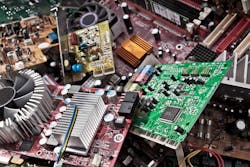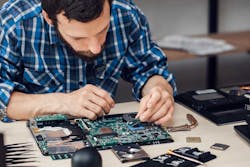What you’ll learn:
- Why modern electronics are so susceptible to thermomechanical fatigue.
- How multiphysics software tools can aid the design process, resulting in better product longevity.
The airbags in your car… the camera on your video doorbell… the phone or other electronic device you’re reading this on right now. The everyday products that make modern life possible wouldn’t be able to run without key electrical components maintaining functionality and stability for years at a time.
And yet, these electrical components experience complex thermal and mechanical loads during the daily course of their operation, or, in the case of the airbag, during long-term passive cycles of environmental heating and cooling while they wait unused within a car’s interior. As producers and consumers require ever more from electronic devices, those devices are becoming more powerful, further increasing the thermal loads being subjected to vital components.
Heat Transfer and Thermal Load
What happens when a circuit board heats up?
Heat can come from various sources and affect circuits in different ways, especially as circuit boards are assembled with increasing density in efforts to make smaller, lighter circuit designs. Heat can be damaging. Printed-circuit-board materials are formulated to withstand a certain amount of heat, but when the temperatures rise to high enough temperatures, circuit performance can suffer, especially at higher frequencies.
One day-to-day example of this is the thermal throttling of our cellphones. As your phone heats up, the phone reduces performance to protect the device, which you notice from the slower response of your phone.
This same type of behavior can occur in large data centers or industrial automation controllers. Typically, these devices have built-in thermal protection. If the processor gets too hot, the built-in protection shuts down the processor.
Thermomechanical Fatigue
Even if the device doesn’t shut down, thermal load—and particularly, differentials in thermal load—can cause design issues. Heat causes most materials to expand, and subsequent cooling results in contraction. In addition, various component materials will expand and contract at different rates, and thermal loads typically vary with time due to changing usage.
For example, electronics typically enter a “sleep” mode to conserve energy. When this happens, there’s a decrease in the thermal loading and operating temperature. Such cyclic loading produces small amounts of fatigue damage that can eventually produce cracking in critical components. These cracks could then lead to component failure.
The Role of Multiphysics Simulation Tools
Engineers are tasked with developing new designs that can withstand increased loadings. But they also must incorporate the expectation of numerous repeated cycles of increased and decreased thermal loading into their designs, with an eye for longevity. One solution to this challenge is to use multiphysics software tools to calculate the lifetime of electronics components before they’re put into production or lengthy testing processes.
These tools can be beneficial in numerous scenarios. They’re a natural fit when considering entirely new designs being built from the ground up, subjected to holistic testing and prototyping during the R&D phase.
Often, though, manufacturers seek to merely tweak specific components within an existing design. As a result, they either don’t properly anticipate the effects that small changes can have on thermomechanical balance and product longevity, or need a way to predict these effects without going through a lengthy and expensive prototyping process. Multiphysics simulation tools can be invaluable assets in both situations.
Early-Stage Partners
Traditionally, the thermal design of electronic assemblies has been left to a relatively late stage in the design processes, when much of the electronics and mechanical design is nearing completion. It’s led to a lot of late-design rework, and often further iterations, due to problems found during physical prototyping.
Consequently, this can mean design costs skyrocket, products are frequently late to market, and there’s not enough time to explore better design approaches and optimization strategies in the upfront design phase where simulation has the most impact.
By using multiphysics simulations that account for conduction, convection, and radiation, engineers can evaluate different key metrics, including rate of heat transfer and junction temperatures, as well as visualize the distribution of heat in critical areas. Engineers can easily test their designs without wasting valuable time and resources.
Simulation is a fast and cost-effective method of evaluating and optimizing the heat-transfer processes in a wide range of prototype geometries and working conditions.
Ensuring Design Longevity
Multiphysics software tools also can perform thermomechanical stress and fatigue analysis, thereby calculating the lifetime of electronics components. These simulations include heat generated by the component, air flow around the component, and radiative heat transfer from the component.
After calculating the thermal environment, the effect of temperature changes on the component stress can be determined. The stress and strain then form the basis for calculating the component lifetime using fatigue damage models. Such an approach enables engineers to design electronics with desired lifetimes.
One example of this type of analysis is the fatigue cracking of solder in ball grid arrays (BGAs). This failure mode is often driven by a combination of thermal gradients and mechanical constraints. AltaSim has conducted these analyses to help mechanical engineers better understand the factors producing the failure mode and methods for mitigation. These analyses typically aren’t done during the initial design phase, but they have been shown to be extremely helpful when BGA failures develop during prototyping.
Process Efficiency
Multiphysics software simulation offers an exceptional opportunity for the electronic components design industry. Uniquely versed simulation engineers can seamlessly plug into the existing engineering capabilities of a company, providing rapid, high-quality virtual prototypes of their design concepts, and identifying potential problems and solutions. The resulting efficiencies and cost savings make simulation a smart choice at multiple points during the design process.


